Sony PRS-505 e-book - the choice and operation
Since the acquisition of the Sony PRS-505, it has now been almost a month, and finally I gathered my strength to share the sensations of this device. It all began like this ...

Caution - traffic!
')
UPD: Added more detailed photos.
The end of April. Spring Moscow morning. After a prolonged winter, the bright rays of the sun flooding the room are perceived especially joyfully. The chirping of birds, the sensations of inner warmth, harmony. So what if the image on the monitor faded, but here it is - the real sun! However, it's not about that. Although the sun's rays still play a role in this article. Let's start ...
Despite the relatively recent appearance of specialized devices for reading on the basis of "electronic paper" (hereinafter referred to as "reader". I don’t really like the word, but it will be clearer), there are already quite a few models on sale now. Most models have already been updated and represent a new generation of email. books. The price for this type of device is steadily declining, although you can’t call it low yet.
As part of this note, I will tell you what I was guided by and why I chose Sony PRS-505 as a result.
It is worth starting with explanations, why I even needed to buy an e-book now and what prevented me from waiting for a half-year-year until prices drop and the choice becomes wider. An e-book is a birthday present for a loved one, because, firstly, it will significantly reduce the weight of the bottomless handbag, and secondly, books bought regularly (many of which can be classified as “read and discarded”) simply have nowhere to put . The answer to the second part of the question - why one cannot wait - is just as simple: I don’t want to wait, because the process is endless, the ideal is unattainable, and I want to enjoy the fruits of progress today.
After the initial selection to the final of the personal competition for the title “desired purchase”, two devices appeared - the Orsio b731 and the Sony PRS-505 . I’ll make a reservation that the older model of the "reader" from Sony under the PRS-700 index was not seriously considered, as it is now significantly more expensive and has no obvious advantages (I’ll be back later on talking about the built-in backlight and touch screen).
Brief introduction
The Orsio b731 e-book from ORSiO Solutions Corporation, a subsidiary of Taiwan-based ODM manufacturer Quanta Computer, is currently the most modern model released under this brand. At the time of this writing, it was available in Moscow retail at an average price of about 14,000 r. A detailed review and technical parameters can be found on the manufacturer's website. I also recommend that you read this review . The main advantages attributed to this reader are support for multiple document formats, a relatively large amount of internal memory, and regular firmware updates. The last point personally seems rather doubtful to me, since it can be regarded as “refinement in progress” - a good product does not need such frequent updates, it functions normally from the beginning.
Electronic book PRS-505 from Sony. The manufacturer needs no introduction. Even without being a “fan”, I can’t help but admit that Sony’s technology almost always stands out and is unmistakably recognized in a number of similar products. The average price in Moscow retail at the time of writing was about 11,500 r. The advantages of the Sony PRS-505 include a thin metal case, a very elegant cover-cover made of high quality leatherette, the presence of a large number of accessories. By cons - the lack of official support in the territory of the Russian Federation, the lack of a power adapter kit, a peculiar attitude to document formats (in the "Sony style" :)).
I admit honestly - the love of Orsio products by the example of e-books did not work out for me. Such an inner subjective feeling when you take a thing in your hand and feel that something is not right. It can be seen that the manufacturer tried, but something is missing. Not so felt, not mine. It seems to be a soft touch cover and a case. But somehow it does not, does not inspire confidence. This is exclusively my opinion, I sincerely respect the opinion of those who think otherwise.
In contrast, the sensations from Sony PRS-505 are the most favorable. Even though I don't like Sony's other appliances. So the story of a furious fan of my story can not be called. So, we meet ...

So why did my choice fall on the Sony PRS-505? And are those differences that argue a lot in forums and blogs that are important?
The reader is thin, lightweight, smaller than a regular DVD box. The appearance and all the sensations from this device easily fit into the notorious slogan “It's a Sony”. You take the book in your hands and you understand, really, but really worked on the design and ergonomics. And not a little. Quality is made up of little things.
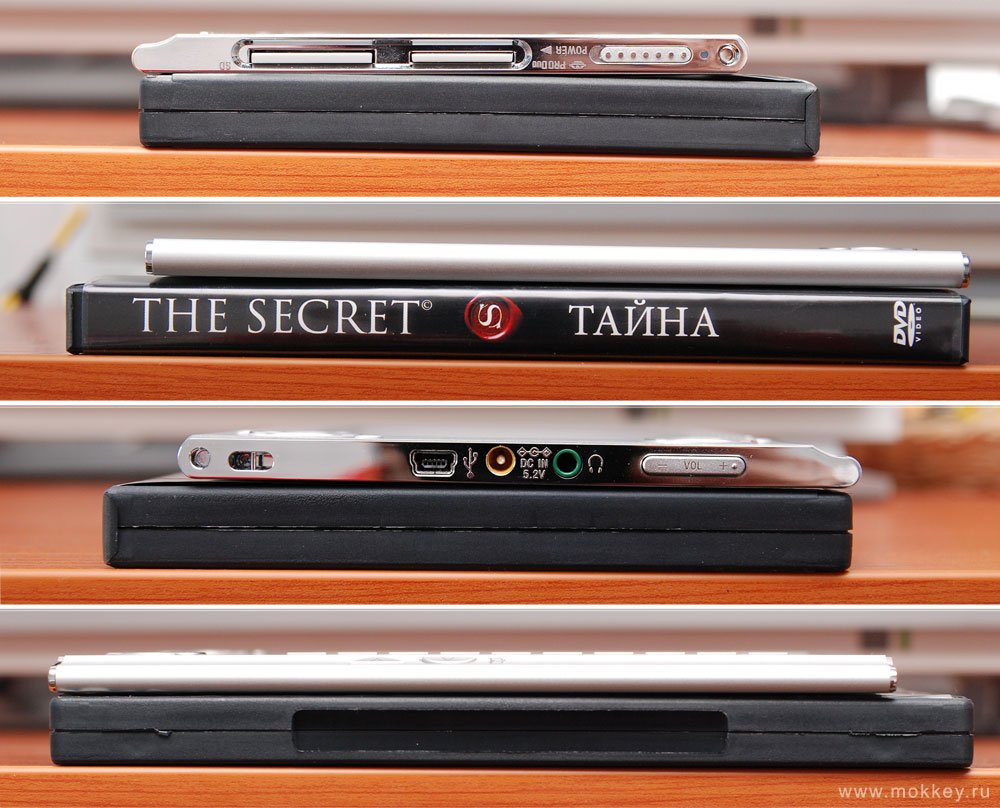
I frankly like the fact that the manufacturer pays so much attention to detail. Be it the caps that close the memory card slots ...
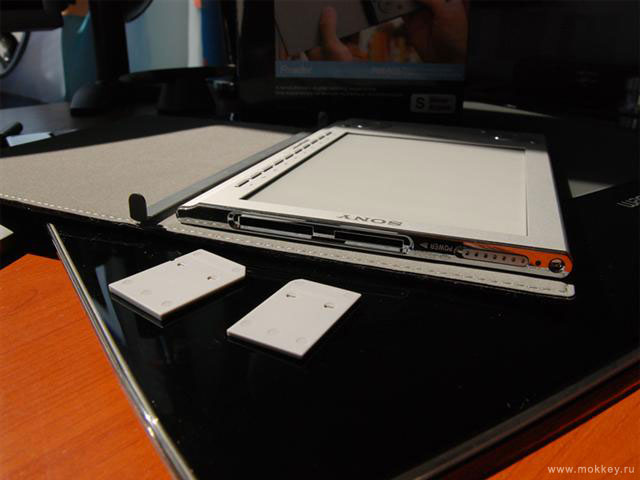
... or eyelets that securely connect the cover and the device itself. Or barely noticeable, but so important magnets embedded in the cover and not allowing the halves to unfold when not necessary.
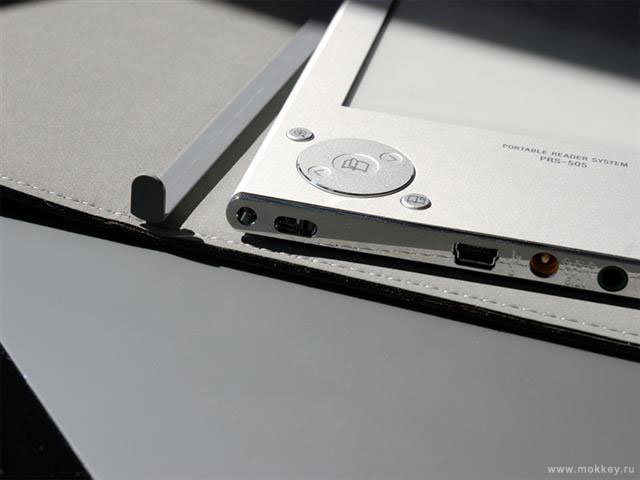
The overall impression of the device - everything is very elegant. Solid.
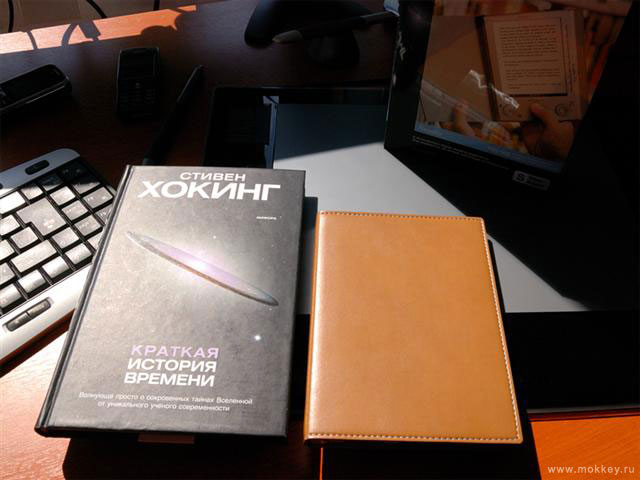

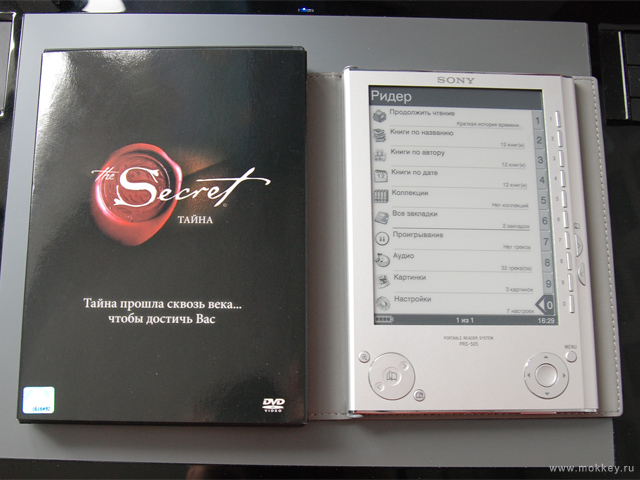

And now about the technical points. The book I bought was already Russified, although initially I was preparing to do this on my own, since there are detailed instructions. I also immediately purchased the power adapter from the electrical network - useful both in terms of charging speed and in terms of additional mobility. True, it should be noted that over the past month of active use, the adapter has not yet been used.
UPD: In the evening of that day, when this note was published, the reader is still dead :) The power adapter is identical to the adapter from the Sony PSP game console.
Format support and performance
Having received the book, I decided to pretend to be lazy specifically - without understanding the bundled cable and disc, I took the first available memory card (it turned out to be a rare 16 MB SD from an old camera), went to lib.ru, downloaded the book in TXT format (“ Alice in the camp of miracles "), saved the card, the card in the reader and everything - less than 30 seconds passed and now" the striped caterpillar sits on the cap of the mushroom with folded arms and quietly smokes a long hookah, paying no attention to either Alice or everything around ”- half a minute and you can read. Convenient to read. And if you spend a little more time and prepare a book, the result will be even better.
It was a txt. Go ahead. Also quickly write down the first PDF document. “Typography” by Emil Ruden is a document that is not simple to work even on computers like netbooks. Drum roll ... The document is open and in principle readable. However, when I tried to apply scaling, I managed to “catch the hang” the first and the last time. I’m not sure that the reader was frozen, but I didn’t wait and, armed with a paper clip, rebooted it. Funny nuance - after a hard reboot due to the peculiarities of the technology on the screen, the image does not disappear until a new reader is turned on. The first time it knocks a little. Similar sensations arise in the process of reading - often you want to poke your finger on the screen. Affects many years of experience using a variety of PDAs with their touch screens. Retraining is not necessary for a long time.
At the moment I liked reading RTF documents the most. Easy to prepare, read document headers. I did not install the official program for the preparation of books and successfully cope without it.
In search of what else would such an “extreme” feed to the reader, the gaze fell on the Nikon D80 SLR. I take out a memory card (SD 4 GB Transcend) - there is RAW (NEF), JPG. The reader has a built-in image viewer with minimal functionality. Photos look very bearable. When opening a photo from a DSLR, he thinks a little longer than usual, but in the end, without any problems, opens a full-sized JPG. Trifle, but nice.
UPD: RAW is not supported!

The 8 GB SD HC camcorder's memory card also worked on Kingston Class 4 without question. In this case, both cards were taken back to the original devices without consequences - Sony PRS-505 did not make changes to the file system and did not leave traces in the form of service files.
Screen
I will be brief - no problems noticed. The sun's rays interfere exactly the same as when reading a paper book.
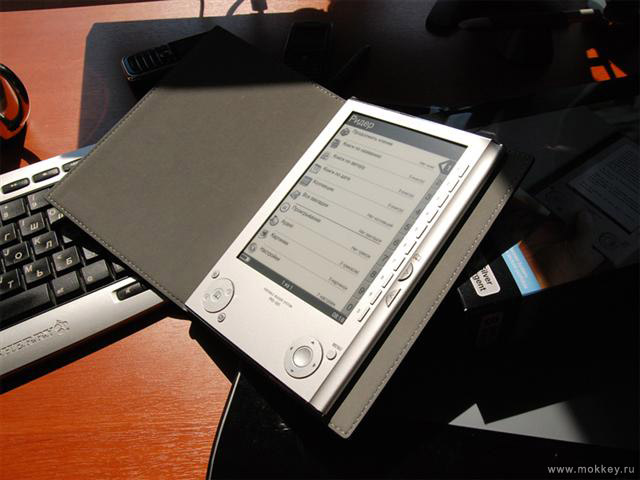
Traces are noticeable if the image is not updated for a long time, but it does not interfere much. Do I need a built-in lights? Not sure. Very unsure. Without her, too good. At least, judging by the implementation of the backlight in its current form on the example of Sony PRS-700.
Memory and file structure
Everyone who saw the reader for the first time immediately asked about the amount of internal memory and lamented that 256 MB is so little. I never understood why everyone is so worried. It never occurs to anyone to constantly carry with them the complete works of classical literature in the format of paper books, but as soon as it comes to the electronic library, there must be everything at once at hand. I suppose that the impact of advertising is having an effect - the more, the better (megabytes, megapixels, gigahertz - the eternal race). People do not want to realize that even on a long vacation it is enough to take 10-15 books and 256 MB of internal memory for such material will be enough for more than. But there are still two slots for memory cards.
The problem of structuring the collection (Sony PRS-505 does not support folders, displaying all books as a list in alphabetical order) with this approach disappears by itself - these 10-15 books are perfectly visible through a single list, it does not cause any difficulties.
Music player
Yes, he is. Very mediocre, drastically reducing battery life from a single battery charge. And if it was not, then nothing terrible happened.
In principle, the same thing with the clock, updating the time only at the time of the commission of any action. For example, when turning the page. It is useful sometimes, but it is possible without them.
And, as I wrote above, the reader is able to view photos, including very “heavy” ones.
Some said that a calculator would be good. My opinion is not necessary. The maximum is the clock. Because there is a wonderful initial concept - a simple device for convenient reading of electronic books. And all the additional "bells and whistles" - an extra reason for the manufacturer to raise the price of their devices. For me, the ideal reader is the cheapest device with excellent ergonomics and high-quality screen. It is created just to read. Need more? Tablet PC to help - a completely different level.
findings
I do not regret at all that I chose the reader from Sony. Most of its shortcomings are contrived and easily overlapped with excellent ergonomics, thoughtful details and the general highest level of manufacturing.
What am I missing? Perhaps DjVu and HTML support. What else? I would change the principle of operation of the LED located on the top. Now he notifies of data transfer when connected to a computer and the charging stage. And I want the LED to show the activity of the device - sometimes when indexing new books or scaling it is not always clear, the reader wonders or hangs.
That's all. I plan in the near future to make the reader more feminine by acquiring an additional accessory - pink leather covers. Otherwise, I and the new owner of Sony PRS-505 are very pleased.
Original article to us on my site .

Caution - traffic!
')
UPD: Added more detailed photos.
The end of April. Spring Moscow morning. After a prolonged winter, the bright rays of the sun flooding the room are perceived especially joyfully. The chirping of birds, the sensations of inner warmth, harmony. So what if the image on the monitor faded, but here it is - the real sun! However, it's not about that. Although the sun's rays still play a role in this article. Let's start ...
Despite the relatively recent appearance of specialized devices for reading on the basis of "electronic paper" (hereinafter referred to as "reader". I don’t really like the word, but it will be clearer), there are already quite a few models on sale now. Most models have already been updated and represent a new generation of email. books. The price for this type of device is steadily declining, although you can’t call it low yet.
As part of this note, I will tell you what I was guided by and why I chose Sony PRS-505 as a result.
It is worth starting with explanations, why I even needed to buy an e-book now and what prevented me from waiting for a half-year-year until prices drop and the choice becomes wider. An e-book is a birthday present for a loved one, because, firstly, it will significantly reduce the weight of the bottomless handbag, and secondly, books bought regularly (many of which can be classified as “read and discarded”) simply have nowhere to put . The answer to the second part of the question - why one cannot wait - is just as simple: I don’t want to wait, because the process is endless, the ideal is unattainable, and I want to enjoy the fruits of progress today.
After the initial selection to the final of the personal competition for the title “desired purchase”, two devices appeared - the Orsio b731 and the Sony PRS-505 . I’ll make a reservation that the older model of the "reader" from Sony under the PRS-700 index was not seriously considered, as it is now significantly more expensive and has no obvious advantages (I’ll be back later on talking about the built-in backlight and touch screen).
Brief introduction
The Orsio b731 e-book from ORSiO Solutions Corporation, a subsidiary of Taiwan-based ODM manufacturer Quanta Computer, is currently the most modern model released under this brand. At the time of this writing, it was available in Moscow retail at an average price of about 14,000 r. A detailed review and technical parameters can be found on the manufacturer's website. I also recommend that you read this review . The main advantages attributed to this reader are support for multiple document formats, a relatively large amount of internal memory, and regular firmware updates. The last point personally seems rather doubtful to me, since it can be regarded as “refinement in progress” - a good product does not need such frequent updates, it functions normally from the beginning.
Electronic book PRS-505 from Sony. The manufacturer needs no introduction. Even without being a “fan”, I can’t help but admit that Sony’s technology almost always stands out and is unmistakably recognized in a number of similar products. The average price in Moscow retail at the time of writing was about 11,500 r. The advantages of the Sony PRS-505 include a thin metal case, a very elegant cover-cover made of high quality leatherette, the presence of a large number of accessories. By cons - the lack of official support in the territory of the Russian Federation, the lack of a power adapter kit, a peculiar attitude to document formats (in the "Sony style" :)).
I admit honestly - the love of Orsio products by the example of e-books did not work out for me. Such an inner subjective feeling when you take a thing in your hand and feel that something is not right. It can be seen that the manufacturer tried, but something is missing. Not so felt, not mine. It seems to be a soft touch cover and a case. But somehow it does not, does not inspire confidence. This is exclusively my opinion, I sincerely respect the opinion of those who think otherwise.
In contrast, the sensations from Sony PRS-505 are the most favorable. Even though I don't like Sony's other appliances. So the story of a furious fan of my story can not be called. So, we meet ...

So why did my choice fall on the Sony PRS-505? And are those differences that argue a lot in forums and blogs that are important?
The reader is thin, lightweight, smaller than a regular DVD box. The appearance and all the sensations from this device easily fit into the notorious slogan “It's a Sony”. You take the book in your hands and you understand, really, but really worked on the design and ergonomics. And not a little. Quality is made up of little things.

I frankly like the fact that the manufacturer pays so much attention to detail. Be it the caps that close the memory card slots ...

... or eyelets that securely connect the cover and the device itself. Or barely noticeable, but so important magnets embedded in the cover and not allowing the halves to unfold when not necessary.

The overall impression of the device - everything is very elegant. Solid.




And now about the technical points. The book I bought was already Russified, although initially I was preparing to do this on my own, since there are detailed instructions. I also immediately purchased the power adapter from the electrical network - useful both in terms of charging speed and in terms of additional mobility. True, it should be noted that over the past month of active use, the adapter has not yet been used.
UPD: In the evening of that day, when this note was published, the reader is still dead :) The power adapter is identical to the adapter from the Sony PSP game console.
Format support and performance
Having received the book, I decided to pretend to be lazy specifically - without understanding the bundled cable and disc, I took the first available memory card (it turned out to be a rare 16 MB SD from an old camera), went to lib.ru, downloaded the book in TXT format (“ Alice in the camp of miracles "), saved the card, the card in the reader and everything - less than 30 seconds passed and now" the striped caterpillar sits on the cap of the mushroom with folded arms and quietly smokes a long hookah, paying no attention to either Alice or everything around ”- half a minute and you can read. Convenient to read. And if you spend a little more time and prepare a book, the result will be even better.
It was a txt. Go ahead. Also quickly write down the first PDF document. “Typography” by Emil Ruden is a document that is not simple to work even on computers like netbooks. Drum roll ... The document is open and in principle readable. However, when I tried to apply scaling, I managed to “catch the hang” the first and the last time. I’m not sure that the reader was frozen, but I didn’t wait and, armed with a paper clip, rebooted it. Funny nuance - after a hard reboot due to the peculiarities of the technology on the screen, the image does not disappear until a new reader is turned on. The first time it knocks a little. Similar sensations arise in the process of reading - often you want to poke your finger on the screen. Affects many years of experience using a variety of PDAs with their touch screens. Retraining is not necessary for a long time.
At the moment I liked reading RTF documents the most. Easy to prepare, read document headers. I did not install the official program for the preparation of books and successfully cope without it.
In search of what else would such an “extreme” feed to the reader, the gaze fell on the Nikon D80 SLR. I take out a memory card (SD 4 GB Transcend) - there is RAW (NEF), JPG. The reader has a built-in image viewer with minimal functionality. Photos look very bearable. When opening a photo from a DSLR, he thinks a little longer than usual, but in the end, without any problems, opens a full-sized JPG. Trifle, but nice.
UPD: RAW is not supported!

The 8 GB SD HC camcorder's memory card also worked on Kingston Class 4 without question. In this case, both cards were taken back to the original devices without consequences - Sony PRS-505 did not make changes to the file system and did not leave traces in the form of service files.
Screen
I will be brief - no problems noticed. The sun's rays interfere exactly the same as when reading a paper book.

Traces are noticeable if the image is not updated for a long time, but it does not interfere much. Do I need a built-in lights? Not sure. Very unsure. Without her, too good. At least, judging by the implementation of the backlight in its current form on the example of Sony PRS-700.
Memory and file structure
Everyone who saw the reader for the first time immediately asked about the amount of internal memory and lamented that 256 MB is so little. I never understood why everyone is so worried. It never occurs to anyone to constantly carry with them the complete works of classical literature in the format of paper books, but as soon as it comes to the electronic library, there must be everything at once at hand. I suppose that the impact of advertising is having an effect - the more, the better (megabytes, megapixels, gigahertz - the eternal race). People do not want to realize that even on a long vacation it is enough to take 10-15 books and 256 MB of internal memory for such material will be enough for more than. But there are still two slots for memory cards.
The problem of structuring the collection (Sony PRS-505 does not support folders, displaying all books as a list in alphabetical order) with this approach disappears by itself - these 10-15 books are perfectly visible through a single list, it does not cause any difficulties.
Music player
Yes, he is. Very mediocre, drastically reducing battery life from a single battery charge. And if it was not, then nothing terrible happened.
In principle, the same thing with the clock, updating the time only at the time of the commission of any action. For example, when turning the page. It is useful sometimes, but it is possible without them.
And, as I wrote above, the reader is able to view photos, including very “heavy” ones.
Some said that a calculator would be good. My opinion is not necessary. The maximum is the clock. Because there is a wonderful initial concept - a simple device for convenient reading of electronic books. And all the additional "bells and whistles" - an extra reason for the manufacturer to raise the price of their devices. For me, the ideal reader is the cheapest device with excellent ergonomics and high-quality screen. It is created just to read. Need more? Tablet PC to help - a completely different level.
findings
I do not regret at all that I chose the reader from Sony. Most of its shortcomings are contrived and easily overlapped with excellent ergonomics, thoughtful details and the general highest level of manufacturing.
What am I missing? Perhaps DjVu and HTML support. What else? I would change the principle of operation of the LED located on the top. Now he notifies of data transfer when connected to a computer and the charging stage. And I want the LED to show the activity of the device - sometimes when indexing new books or scaling it is not always clear, the reader wonders or hangs.
That's all. I plan in the near future to make the reader more feminine by acquiring an additional accessory - pink leather covers. Otherwise, I and the new owner of Sony PRS-505 are very pleased.
Original article to us on my site .
Source: https://habr.com/ru/post/60162/
All Articles